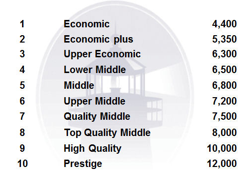
Trustees should be aware of the four statutory functions of a body corporate in respect of the insurance:
To insure against such other risks as the owners may by special resolution determine;
To apply any insurance money received by it in respect of damage to the building or buildings, in rebuilding and reinstating the building or buildings in so far as this may be effected;
To pay the premiums on any policy of insurance effected by it.
Prescribed management rules (PMRs), and particularly PMR 29, set out in more detail how insurance should be controlled, managed and administered.
For simplicity’s sake, lets break PMR 29 into its four sub-rules and what they deal with:
| 29.1 | The insurance of the buildings themselves Loss of rent or loss of occupation Any other risks The schedule of replacement values |
| 29.2 | Liability cover Fidelity cover |
| 29.3 | Other risks |
| 29.4 | Excesses |
1) Find out when the buildings were last valued or how the present sums insured were determined.
2) Obtain a full copy of your present insurance policy and schedule of replacement values
3) Do a rough “back of the cigarette box” estimation as follows:
Take the total square metres of the sections (from the sectional plan / PQ schedule) and multiply it by an average building rate per square metre.
Some rough ideas of what one might expect a townhouse simplex or duplex building to cost per square metre (excluding VAT) in 2010:

So, set out your rough check as follows:
| Property description |
Sqm | Rate per sqm |
Amount |
| Residential sections | 1,000 |
7,500 |
7,500,000 |
| Garage sections |
200 |
3,000 |
600,000 |
| Subtotal |
8,100,000 | ||
| Add 10% to 15% or so for common area |
594,000 | ||
| Subtotal |
8,910,000 | ||
| Add 12% for professional fees |
1,069,200 | ||
| Add 14% VAT |
1,397,088 | ||
| Add 5% for removal of debris |
568,814 | ||
| Roughly estimated replacement cost |
R 11,945,102 |
4) If you seem to be underinsured, increase your cover up to at least your estimated amount and also set about arranging for a professional valuer to value your buildings – this should be done every two or three years.
5) Check your policy document – does the cover described match that set out in prescribed management rules or your particular body corporate rules?
| Check the following: a) Premiums are paid up to date. b) The risk address stated matches the street address of the buildings. c) The policy is preferably a body corporate policy, such as one issued by an underwriting manager specialising in sectional title. d) Does the schedule of replacement costs as agreed to at your recent annual general meeting match that reflected in the policy? e) There is sufficient public liability cover (minimum R10,000,000 but preferably more), and preferably trustees indemnity extension. f) There is preferably accidental damage cover and all risk cover for items that are at risk of theft, such as air-conditioning units, aerials, cameras, etc. g) Do the excesses seem reasonable? h) Obtain a claims history and check it – look for trend and problem areas. 6) Check who your insurance advisor or broker is and ask for a copy of the last written advice and comparative quotations. 7) Check that you or your managing agent has a copy of your broker’s FAIS licence on file. 8) Check whether your insurance advisor has a good understanding of and experienced in sectional title matters. 9) Check that the insurance advisor has professional indemnity cover. |
Another insurance aspect that should be considered is fidelity cover. Prescribed management rules suggest that the amount of cover, if any, should be determined by the owners in a general meeting. This is often overlooked and should even be considered where the managing agent holds a Fidelity Fund Certificate and funds are being managed through the managing agent’s trust account.
Trustees need to make sure that they are receiving appropriate insurance advice in this regard and re-visit how banking and signing power arrangements are covered. Fidelity cover can be structured accordingly. There are many different ideas floating around about which method is most appropriate – for example, whether the body corporate should manage its own bank account or whether funds should be collected in the managing agent’s trust account.
Trustees should also check that all professionals they deal with have appropriate professional indemnity cover. This will include your insurance broker, property valuer, auditor, attorney and your managing agent.
Trustees should also ensure that any contractor who attends to works on common property has appropriate contractors’ all-risk cover. Obtain confirmation of such before any works commences.
Remember that schedule mentioned above under point 5 – once you have had the buildings re-valued, see to it that a fresh schedule is prepared. Your managing agent should be able to assist you with this. Some specialist insurance advisors are geared to assist you here, but take care: it is not the insurance company’s place to prepare such a schedule – it’s between you and your managing agent to get this done properly and to keep it maintained and up to date.
It should NOT be a simple photocopy of the insurance company’s schedule; rather, the insurance policy should be updated to reflect a mirror image of the body corporate’s schedule of replacement values.
Trustees and owners can learn more about these and other important aspects by attending a workshop near you. See www.addsure.co.za and www.addsure.blogspot.com for more information.
Mike Addison is the director of Addsure, specialist sectional title insurance brokers and is a regular contributor to Paddocks Press.
Article reference: Volume 5, Issue 10, Page 2
Recent Posts
Archives
- June 2025
- May 2025
- April 2025
- March 2025
- February 2025
- January 2025
- December 2024
- November 2024
- October 2024
- August 2024
- July 2024
- June 2024
- May 2024
- April 2024
- March 2024
- February 2024
- January 2024
- December 2023
- November 2023
- October 2023
- September 2023
- August 2023
- July 2023
- June 2023
- May 2023
- April 2023
- March 2023
- February 2023
- January 2023
- December 2022
- November 2022
- October 2022
- September 2022
- August 2022
- July 2022
- June 2022
- May 2022
- April 2022
- March 2022
- February 2022
- January 2022
- December 2021
- November 2021
- October 2021
- September 2021
- August 2021
- July 2021
- June 2021
- May 2021
- April 2021
- March 2021
- February 2021
- January 2021
- December 2020
- November 2020
- October 2020
- September 2020
- August 2020
- July 2020
- June 2020
- May 2020
- April 2020
- March 2020
- February 2020
- January 2020
- December 2019
- November 2019
- October 2019
- September 2019
- August 2019
- July 2019
- June 2019
- May 2019
- April 2019
- March 2019
- February 2019
- January 2019
- December 2018
- November 2018
- October 2018
- September 2018
- August 2018
- July 2018
- June 2018
- May 2018
- April 2018
- March 2018
- February 2018
- January 2018
- December 2017
- November 2017
- October 2017
- September 2017
- August 2017
- July 2017
- June 2017
- May 2017
- April 2017
- March 2017
- February 2017
- January 2017
- December 2016
- November 2016
- October 2016
- September 2016
- August 2016
- July 2016
- June 2016
- May 2016
- April 2016
- March 2016
- February 2016
- January 2016
- December 2015
- November 2015
- October 2015
- September 2015
- August 2015
- July 2015
- June 2015
- May 2015
- April 2015
- March 2015
- February 2015
- January 2015
- December 2014
- November 2014
- October 2014
- September 2014
- August 2014
- July 2014
- June 2014
- May 2014
- April 2014
- March 2014
- February 2014
- January 2014
- December 2013
- November 2013
- October 2013
- September 2013
- August 2013
- July 2013
- June 2013
- May 2013
- April 2013
- March 2013
- February 2013
- January 2013
- December 2012
- November 2012
- October 2012
- September 2012
- August 2012
- July 2012
- June 2012
- May 2012
- April 2012
- March 2012
- February 2012
- January 2012
- December 2011
- November 2011
- October 2011
- September 2011
- August 2011
- July 2011
- June 2011
- May 2011
- April 2011
- March 2011
- February 2011
- January 2011
- December 2010
- November 2010
- October 2010
- September 2010
- August 2010
- July 2010
- June 2010
- May 2010
- April 2010
- March 2010
- February 2010
- January 2010
- December 2009
- November 2009
- October 2009
- September 2009
- August 2009
- July 2009
- June 2009
- March 2009
- February 2009
- February 2008
- February 2007


Recent Comments